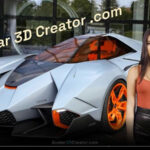Working for you 24 بغیر نیند کے دن میں گھنٹے! 🙂
OUR 3D AVATAR INCLUDES:
– Your Professional Realistic 3D avatar full body created from your photo
– Avatar 3D Studio viewer to share your 3D avatar on social media, websites or videos
– Facial movements (mouth speaking, blinking, smile, kiss, sad, serious, move neck)
– Different preset background types available (image, video, youtube video)
–NEW & FREE! The ability for your avatar to speech your text.
Offer Price: $ 50.00
$ 100.00
OUR 3D AVATAR INCLUDES:
– Your Professional Realistic 3D avatar full body created from your photo
– Avatar 3D Studio viewer to share your 3D avatar on social media, websites or videos
– Facial movements (mouth speaking, blinking, smile, kiss, sad, serious, move neck)
– Different preset background types available (image, video, youtube video)
–NEW & FREE! The ability for your avatar to speech your text.
Offer Price: $ 50.00
$ 100.00
- بلینڈر: ہڈیوں کی گردش کو براہ راست تبدیل کرنے والی 3D حرکت پذیری بنائیں
- Plan the animation.This point can’t be emphasized enough: Know what you’re going to animate and have an idea about the timing of the motion. Act out the action. If you can, record yourself acting it out. Video reference is key for seeing subtle movements. Sketch out a few quick thumbnail drawings of the sequence. Even stick-figure drawings can be really helpful for determining poses and figuring out camera framing.
- Set your timeline cursor at frame 1 and create the starting pose for your character by manipulating its rig in Pose mode.
- Select all visible bones (Select→All) and Insert a LocRotScale keyframe for everything (Pose→Animation→Insert Keyframe→LocRotScale).Granted, there’s a good chance that most of the bones can’t be moved or scaled, but only rotated, so setting a location or scale keyframe for them is kind of moot. However, setting a keyframe for all the bones is faster than going through and figuring out which bones can be keyed for just rotation and which bones can be keyed for some combination of rotation, location, and scale.Alternatively, if you’ve set up a keying set for your character, you can pick that keying set from within the Keying rollout in the Timeline. Then you can insert keyframes for every property in that keying set just by pressing I.
- Within the Dope Sheet, make sure all your recently added channels are selected (they should be by default) and change the interpolation type to Constant (Key→Interpolation Mode→Constant).This is kind of an optional step, but it’s really helpful for the blocking pass of your animation. With Constant interpolation set, you can focus exclusively on your character’s poses and the timing between those poses without the distraction of seeing how Blender generates the in-betweens for you.
- Move the timeline cursor forward to roughly when you think the next major pose should happen.It doesn’t really matter which editor you use to adjust the timeline cursor. It could be the Timeline, the Dope Sheet, or the Graph Editor. In fact, using ←and →, you can even adjust the timeline cursor from the 3D Viewport.
- Create your character’s second pose.If the next pose is a hold, or a pose where the character doesn’t change position, you can duplicate the keys of the previous pose by selecting them in the Dope Sheet and choosing Key→Duplicate or by pressing Shift+D.
- Select all visible bones (A) and Insert an Available keyframe (Pose→Animation→Insert Keyframe→Available).Again, if you’re using a keying set, you can just press I. If you wanted, you could also switch to the Available keying set in the Timeline before inserting keyframes.
- Continue with Steps 5 through 7 until you complete the last major pose for your character.
- Using the Dope Sheet, play back the animation (Spacebar), paying close attention to timing.At this point, hopefully your poses are acceptably refined, so you should pay even more attention to timing than to the accuracy of the poses.
- Go through the keys in the Dope Sheet and tweak the timing of the poses so that they look natural.
- Continuing to tweak, go back and start adding additional poses and keyframes for secondary motion between your major poses.Somewhere around here you’ve migrated from the blocking phase of animation to the refining phase. So at this point, you may want to select all the keys in your animation and switch back to Bézier interpolation (Key→Interpolation Mode→Bézier). Now you can focus on perfecting the
- Continue on this course, refining the timing and detail more and more with each pass.
One luxury of computer animation is the ability to continually go back and tweak things, تبدیلیاں کرنا, اور حرکت پذیری کو بہتر بنائیں. آپ اپنے آپ کو پاسز میں کام کرنے کی تربیت دے کر بلینڈر میں اس عمل سے فائدہ اٹھا سکتے ہیں۔. اپنے سب سے بڑے کردار کو متحرک کریں۔, سب سے زیادہ واضح تحریک پہلے. یقینی بنائیں کہ آپ کے پاس ٹائمنگ کم ہے۔. پھر اگلے پاس پر جائیں۔, کارکردگی کے قدرے تفصیلی حصوں پر کام کرنا.
مثال کے طور پر, اس سے پہلے کہ آپ انگلیوں کو متحرک کرنے کی سخت تفصیلات میں داخل ہوں اپنے کردار کے بازو اور ہاتھ کی ہڈیوں کو متحرک کریں۔. اس طرح کام کرنے کی سب سے بڑی وجہ وقت ہے۔. It’s much easier to go in and fix the timing on a big action if you do it earlier.
Otherwise, you run into situations where you find yourself shuffling around a bunch of detail keys after you find out that your character doesn’t get from Point A to Point B in the right amount of time.
